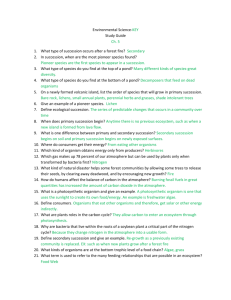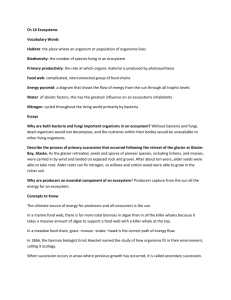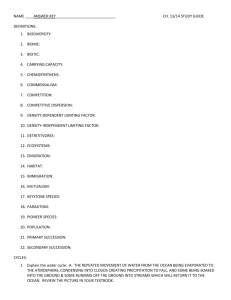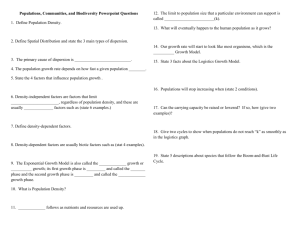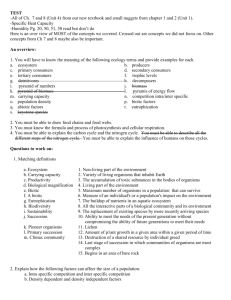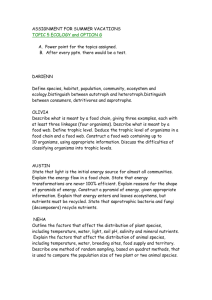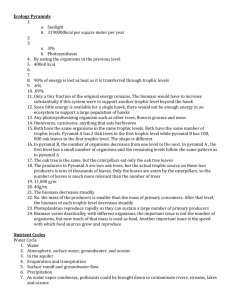Env Sci Ch 5 Study Guide KEY
advertisement
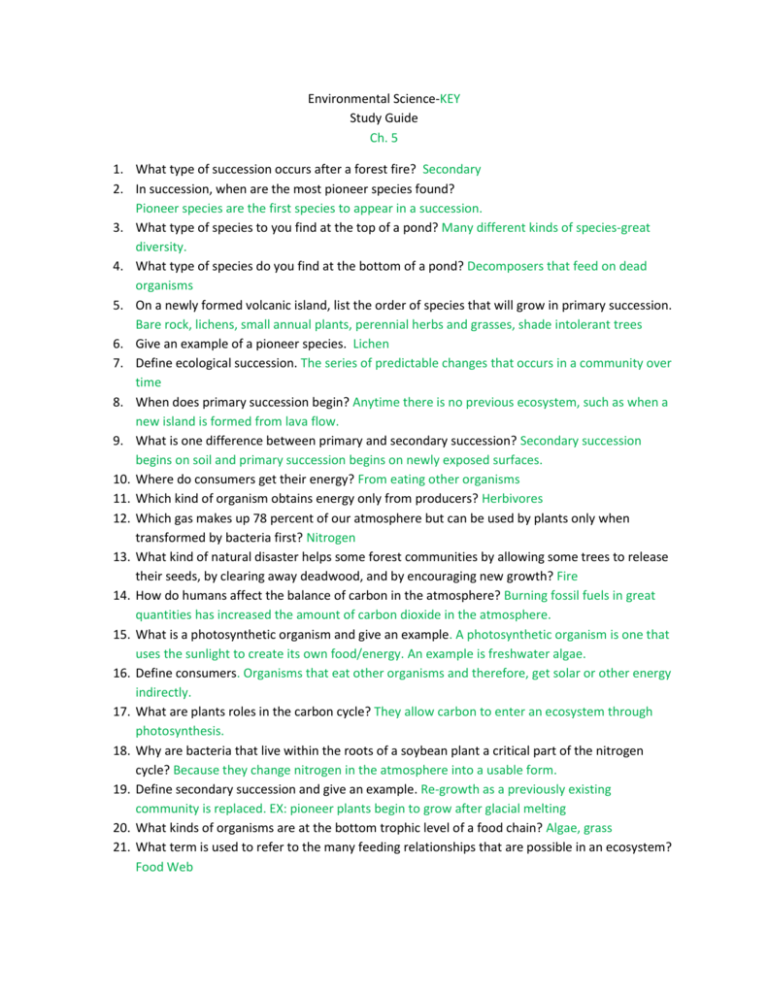
Environmental Science-KEY Study Guide Ch. 5 1. What type of succession occurs after a forest fire? Secondary 2. In succession, when are the most pioneer species found? Pioneer species are the first species to appear in a succession. 3. What type of species to you find at the top of a pond? Many different kinds of species-great diversity. 4. What type of species do you find at the bottom of a pond? Decomposers that feed on dead organisms 5. On a newly formed volcanic island, list the order of species that will grow in primary succession. Bare rock, lichens, small annual plants, perennial herbs and grasses, shade intolerant trees 6. Give an example of a pioneer species. Lichen 7. Define ecological succession. The series of predictable changes that occurs in a community over time 8. When does primary succession begin? Anytime there is no previous ecosystem, such as when a new island is formed from lava flow. 9. What is one difference between primary and secondary succession? Secondary succession begins on soil and primary succession begins on newly exposed surfaces. 10. Where do consumers get their energy? From eating other organisms 11. Which kind of organism obtains energy only from producers? Herbivores 12. Which gas makes up 78 percent of our atmosphere but can be used by plants only when transformed by bacteria first? Nitrogen 13. What kind of natural disaster helps some forest communities by allowing some trees to release their seeds, by clearing away deadwood, and by encouraging new growth? Fire 14. How do humans affect the balance of carbon in the atmosphere? Burning fossil fuels in great quantities has increased the amount of carbon dioxide in the atmosphere. 15. What is a photosynthetic organism and give an example. A photosynthetic organism is one that uses the sunlight to create its own food/energy. An example is freshwater algae. 16. Define consumers. Organisms that eat other organisms and therefore, get solar or other energy indirectly. 17. What are plants roles in the carbon cycle? They allow carbon to enter an ecosystem through photosynthesis. 18. Why are bacteria that live within the roots of a soybean plant a critical part of the nitrogen cycle? Because they change nitrogen in the atmosphere into a usable form. 19. Define secondary succession and give an example. Re-growth as a previously existing community is replaced. EX: pioneer plants begin to grow after glacial melting 20. What kinds of organisms are at the bottom trophic level of a food chain? Algae, grass 21. What term is used to refer to the many feeding relationships that are possible in an ecosystem? Food Web 22. What is the role of nitrogen-fixing bacteria? It is responsible for making nitrogen in the atmosphere usable by living organisms 23. What is a carbon sink? carbon in the atmosphere in the form of carbon dioxide and carbon found within limestone rocks 24. What type of vegetation would you find in an area that has not been disturbed for 150 years? Tall, mature oak trees 25. What is one of the largest carbon reservoirs on Earth? Limestone 26. Define autotrophs and give an example. Organisms that make their own food, EX: Trees 27. Define heterotrophs and give an example. Organisms that cannot make their own food and must obtain energy from the foods they eat, EX: Humans 28. What is the equation for cellular respiration? 29. How does cellular respiration release energy? By breaking down food molecules 30. Give an example of a producer and a consumer in the same food chain. A zebra eating grass 31. What is found at each level of an ecological (energy) pyramid (beginning at the bottom)? Producer, primary consumer, secondary consumer, tertiary consumer 32. How much energy is available to the organisms in each level of the energy (ecological) pyramid? Ten percent of the energy available in the level below. 33. Define succession. The regular progression of species replacement in an environment. 34. What begins a food web? A producer (such as algae) 35. Define a food chain. The series of organisms showing a single feeding relationship in an ecosystem. 36. Define a food web. Multiple food chains together showing all the possible feeding relationships in an ecosystem. 37. Be able to follow a food web diagram. 38. At what trophic level are animals that feed on plants? 2nd trophic level (primary consumers) 39. What limits the number of trophic levels in an ecological pyramid? the amount of energy that is lost at each trophic level 40. How does the number of organisms change as you move from one trophic level to the next? As you move up the pyramid, the number of organisms decreases so the amount of usable energy decreases. 41. Define biogeochemical cycle. Water and minerals needed by all organisms on Earth pass back and forth between the biotic and abiotic portions of the environment. 42. List the components of the water cycle and define each. Precipitation- rain, snow, sleet, or hail that falls to the ground Evaporation-to change to vapor Condensation- the conversion of a vapor or gas to a liquid 43. What happens in the nitrogen cycle? conversion of atmospheric nitrogen into usable organic compounds by bacteria and conversion of nitrogen from decaying organisms into ammonia 44. What is common to the carbon cycle, the nitrogen cycle, and the water cycle? The substance converted in each cycle is required by all living things and is involved in many processes that occur in all living things. 45. List 2 things you know about coal, oil and natural gas. 1) they release carbon dioxide when they are burned 2) they are fossil fuels 46. What percentage of energy is lost between trophic levels? 90% 47. What is the ultimate source of energy for the food (energy) pyramid? Sunlight 48. Photosynthesis uses sunlight to convert water and carbon dioxide into what? oxygen and highenergy sugars 49. What is found on the roots of plants that fix Nitrogen so the plant can use it? Bacteria 50. On an energy pyramid, which level has the smallest number of organisms? The top
